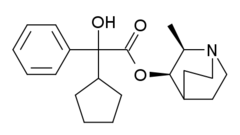CX614
CX614 | |
 | |
| 임상자료 | |
|---|---|
| 기타 이름 | CX-614 |
| 법적현황 | |
| 법적현황 |
|
| 식별자 | |
| |
| CAS 번호 | |
| 펍켐 CID | |
| IUPHAR/BPS | |
| 켐스파이더 | |
| 유니 | |
| CompTox 대시보드 (EPA) | |
| 화학 및 물리적 데이터 | |
| 공식 | C13H13NO4 |
| 어금질량 | 247.250 g·190−1 |
| 3D 모델(JSmol) | |
| |
| |
| (iii) | |
CX-614는 코텍스제약이 개발한 암파킨제다.AMPA 수용체에 미치는 영향에 대해 조사되어 왔다.[1]
만성 CX-614 치료는 뇌에서 유래된 신경퇴행성인자 BDNF의 합성을 빠르게 증가시켜 시냅스 가소성에[2] 매우 중요한 영향을 미치고 알츠하이머병과 같은 신경퇴행성 질환의 치료에 응용할 수 있다.
급성 CX-614 치료는 덴드라이트[3] 내 국소 mRNA 변환(신 단백질 합성)을 활성화하며, 이는 BDNF 방출의 빠른 상향 조절에 의해 매개된다.BDNF의 CX-614 의존적 방출은 ARC/Arg3.1과 CaMK와 같은 시냅스 가소성에 중요한 단백질들의 번역을 빠르게 증가시킨다.II알파.[3]
CX-614도 우울증, 조현병 등의 질환에 대한 치료제로 제안됐지만 만성 투여에 따른 수용체 다운 조절을 생성해 장기 사용 가능성이 제한될 수 있다.[4][5][6][7]
단, CX-614 투여가 장기화된 AMPA 수용체의 하향 조절은 짧고 간헐적인 치료 프로토콜을 설계하고 사용함으로써 피할 수 있으며, 이는 여전히 AMPA 수용체 수준을 낮추지 않고 BDNF 단백질 수준을 상향 조절할 수 있다.[8]
중요한 것은 그러한 짧고 간헐적인 치료 프로토콜은 배양된 중간뇌(메스팔릭)와 해마 유기형 슬라이스에서 MPTP와 MPP로+ 유도된 신경독성에 대해 신경보호성이 있다는 점이다.[9]
이러한 결과는 CX-614의 신경보호 효과를 밝혀냈고, 파킨슨병과 알츠하이머병의 중요한 새로운 치료법으로 CX-614를 추가 실험할 수 있는 길을 열어준 것으로 나타났다.
CX-614는 또한 생쥐에서 필로폰의 행동 효과를 감소시키는 것으로 나타났으며, 각성제 남용 치료에 응용되었을 수 있다.[10]
참고 항목
참조
- ^ Arai AC, Kessler M, Rogers G, Lynch G (2000). "Effects of the potent ampakine CX614 on hippocampal and recombinant AMPA receptors: interactions with cyclothiazide and GYKI 52466". Mol. Pharmacol. 58 (4): 802–13. doi:10.1124/mol.58.4.802. PMID 10999951.
- ^ Lauterborn JC, Truong GS, Baudry M, Bi X, Lynch G, Gall CM (Oct 2003). "Chronic elevation of brain-derived neurotrophic factor by ampakines". J Pharmacol Exp Ther. 307 (1): 297–305. doi:10.1124/jpet.103.053694. PMID 12893840. S2CID 1235935.
- ^ a b Jourdi H, Hsu YT, Zhou M, Qin Q, Bi X, Baudry M (Jul 2009). "POSITIVE AMPA RECEPTOR MODULATION RAPIDLY STIMULATES BDNF RELEASE AND INCREASES DENDRITIC mRNA TRANSLATION". J. Neurosci. 29 (27): 8688–8697. doi:10.1523/JNEUROSCI.6078-08.2009. PMC 2761758. PMID 19587275.
- ^ Jin R, Clark S, Weeks AM, Dudman JT, Gouaux E, Partin KM (Sep 2005). "Mechanism of positive allosteric modulators acting on AMPA receptors". J. Neurosci. 25 (39): 9027–36. doi:10.1523/JNEUROSCI.2567-05.2005. PMC 6725607. PMID 16192394.
- ^ Lynch G (Feb 2006). "Glutamate-based therapeutic approaches: ampakines". Curr Opin Pharmacol. 6 (1): 82–8. doi:10.1016/j.coph.2005.09.005. PMID 16361116.
- ^ Jourdi H, Lu X, Yanagihara T, et al. (Jul 2005). "Prolonged Positive Modulation of α-Amino-3-hydroxy-5-methyl-4-isoxazolepropionic Acid (AMPA) Receptors Induces Calpain-Mediated PSD-95/Dlg/ZO-1 Protein Degradation and AMPA Receptor Down-Regulation in Cultured Hippocampal Slices". J Pharmacol Exp Ther. 314 (1): 16–26. doi:10.1124/jpet.105.083873. PMC 1554891. PMID 15784649.
- ^ Mitchell NA, Fleck MW (Apr 2007). "Targeting AMPA Receptor Gating Processes with Allosteric Modulators and Mutations". Biophys. J. 92 (7): 2392–402. Bibcode:2007BpJ....92.2392M. doi:10.1529/biophysj.106.095091. PMC 1864835. PMID 17208968.
- ^ Lauterborn JC, Pineda E, Chen LY, Ramirez EA, Lynch G, Gall CM (Mar 2009). "Ampakines cause sustained increases in BDNF signaling at excitatory synapses without changes in AMPA receptor subunit expression". Neuroscience. 159 (1): 283–295. doi:10.1016/j.neuroscience.2008.12.018. PMC 2746455. PMID 19141314.
- ^ Jourdi H, Hamo L, Oka T, Seegan A, Baudry M (Apr 2009). "BDNF mediates the neuroprotective effects of positive AMPA receptor modulators against MPP+-induced toxicity in cultured hippocampal and mesencephalic slices". Neuropharmacology. 56 (5): 876–885. doi:10.1016/j.neuropharm.2009.01.015. PMC 3659791. PMID 19371576.
- ^ Hess US, Whalen SP, Sandoval LM, Lynch G, Gall CM (2003). "Ampakines reduce methamphetamine-driven rotation and activate neocortex in a regionally selective fashion". Neuroscience. 121 (2): 509–21. doi:10.1016/S0306-4522(03)00423-8. PMID 14522010. S2CID 23287000.


